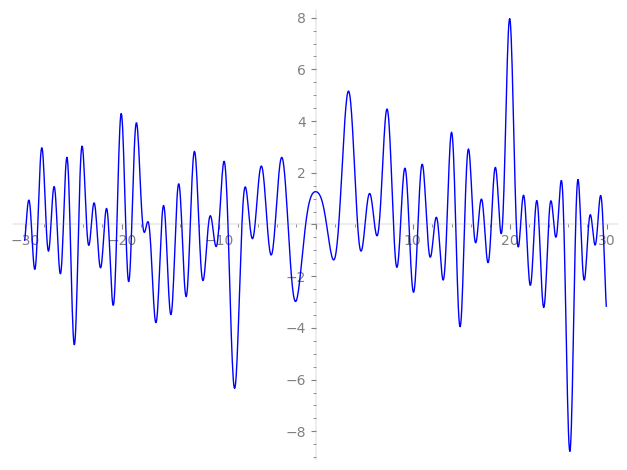| L(s) = 1 | + (−1.66 + 0.493i)3-s + (1.09 + 1.89i)5-s + (0.451 − 2.60i)7-s + (2.51 − 1.63i)9-s + (1.45 + 0.837i)11-s − 1.56i·13-s + (−2.74 − 2.60i)15-s + (−0.278 − 0.160i)17-s + (−2.87 − 4.97i)19-s + (0.537 + 4.55i)21-s + (3.26 + 5.65i)23-s + (0.114 − 0.198i)25-s + (−3.36 + 3.96i)27-s + 7.04·29-s + (7.76 + 4.48i)31-s + ⋯ |
| L(s) = 1 | + (−0.958 + 0.285i)3-s + (0.488 + 0.845i)5-s + (0.170 − 0.985i)7-s + (0.837 − 0.546i)9-s + (0.437 + 0.252i)11-s − 0.432i·13-s + (−0.709 − 0.671i)15-s + (−0.0676 − 0.0390i)17-s + (−0.659 − 1.14i)19-s + (0.117 + 0.993i)21-s + (0.681 + 1.17i)23-s + (0.0229 − 0.0396i)25-s + (−0.646 + 0.762i)27-s + 1.30·29-s + (1.39 + 0.805i)31-s + ⋯ |
Λ(s)=(=(672s/2ΓC(s)L(s)(0.982−0.188i)Λ(2−s)
Λ(s)=(=(672s/2ΓC(s+1/2)L(s)(0.982−0.188i)Λ(1−s)
| Degree: |
2 |
| Conductor: |
672
= 25⋅3⋅7
|
| Sign: |
0.982−0.188i
|
| Analytic conductor: |
5.36594 |
| Root analytic conductor: |
2.31645 |
| Motivic weight: |
1 |
| Rational: |
no |
| Arithmetic: |
yes |
| Character: |
χ672(431,⋅)
|
| Primitive: |
yes
|
| Self-dual: |
no
|
| Analytic rank: |
0
|
| Selberg data: |
(2, 672, ( :1/2), 0.982−0.188i)
|
Particular Values
| L(1) |
≈ |
1.26555+0.120380i |
| L(21) |
≈ |
1.26555+0.120380i |
| L(23) |
|
not available |
| L(1) |
|
not available |
L(s)=p∏Fp(p−s)−1 | p | Fp(T) |
|---|
| bad | 2 | 1 |
| 3 | 1+(1.66−0.493i)T |
| 7 | 1+(−0.451+2.60i)T |
| good | 5 | 1+(−1.09−1.89i)T+(−2.5+4.33i)T2 |
| 11 | 1+(−1.45−0.837i)T+(5.5+9.52i)T2 |
| 13 | 1+1.56iT−13T2 |
| 17 | 1+(0.278+0.160i)T+(8.5+14.7i)T2 |
| 19 | 1+(2.87+4.97i)T+(−9.5+16.4i)T2 |
| 23 | 1+(−3.26−5.65i)T+(−11.5+19.9i)T2 |
| 29 | 1−7.04T+29T2 |
| 31 | 1+(−7.76−4.48i)T+(15.5+26.8i)T2 |
| 37 | 1+(−0.946+0.546i)T+(18.5−32.0i)T2 |
| 41 | 1+3.44iT−41T2 |
| 43 | 1−11.6T+43T2 |
| 47 | 1+(−2.25−3.90i)T+(−23.5+40.7i)T2 |
| 53 | 1+(4.42−7.67i)T+(−26.5−45.8i)T2 |
| 59 | 1+(5.37+3.10i)T+(29.5+51.0i)T2 |
| 61 | 1+(−3.80+2.19i)T+(30.5−52.8i)T2 |
| 67 | 1+(0.716−1.24i)T+(−33.5−58.0i)T2 |
| 71 | 1−6.37T+71T2 |
| 73 | 1+(4.49−7.77i)T+(−36.5−63.2i)T2 |
| 79 | 1+(−3.58+2.07i)T+(39.5−68.4i)T2 |
| 83 | 1+9.06iT−83T2 |
| 89 | 1+(−4.57+2.64i)T+(44.5−77.0i)T2 |
| 97 | 1−4.23T+97T2 |
| show more | |
| show less | |
L(s)=p∏ j=1∏2(1−αj,pp−s)−1
Imaginary part of the first few zeros on the critical line
−10.65067438052112579374656976473, −9.967392569365098419867796232857, −9.047637746933330444654188467343, −7.60607428345784660637800341060, −6.79393330629371334815965874833, −6.25577678369048567540457599444, −4.99794744931052194245462834413, −4.18367968130574883797994907628, −2.85465793280021317871943817650, −1.04101922771862168294472133804,
1.11772078575837535168978741870, 2.37154115504505573980526093247, 4.31743447306163495206882182477, 5.08284785578325137829620472059, 6.06500615978195378971839681642, 6.53730810416618329294284843531, 8.015472152129602021917846587247, 8.745501626997243903087725562614, 9.616210322301302814318405194819, 10.54112400353428642845564658909

